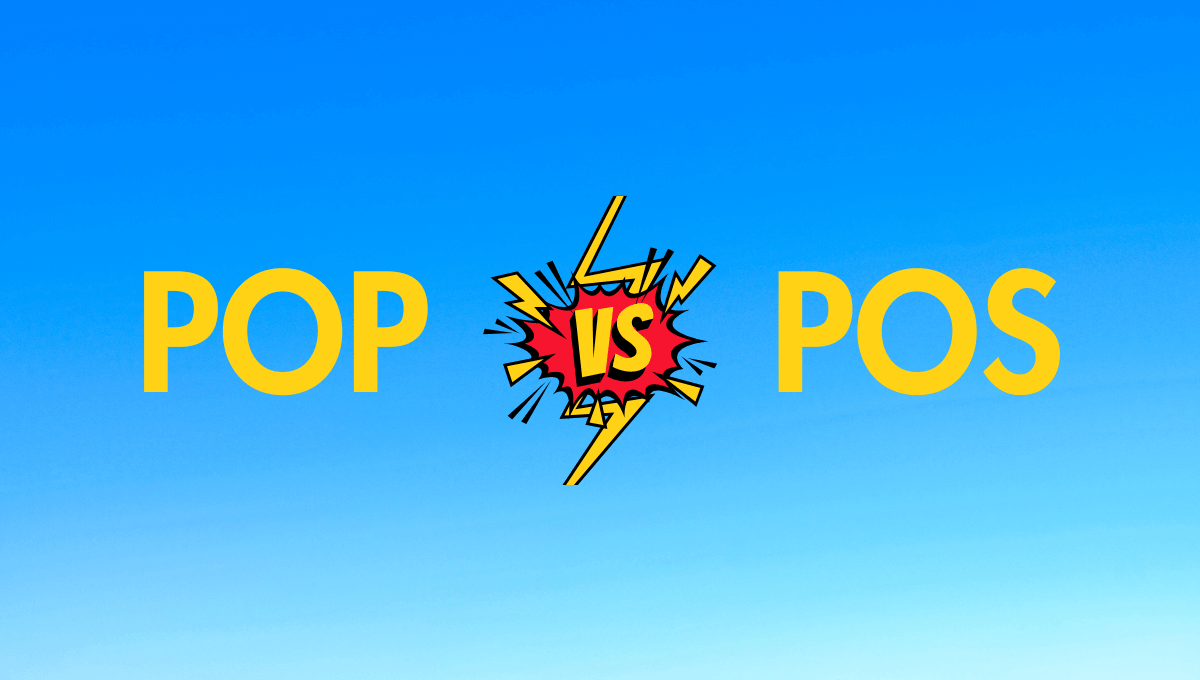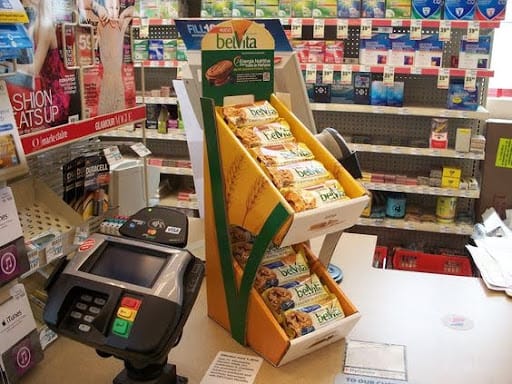POP vs. POS Displays: Which is Best for Your Business?

The first impression is the last and most important. This phrase is rightly said and implemented in every industry. To make an unforgettable first impression, brands use compelling displays. It's a great way to achieve the goal of grabbing customers' attention. But most often, brands attract people but fail to convert them into paying customers. What does that happen?
It's because they don't choose the right display style. You should consider several factors before choosing the best display for your business. There are primarily two types of displays: POP and POS displays.
But how can you make the right decision? What's the procedure for choosing a display style?
It's extremely important to understand the difference between both displays. This will help you better utilize and display impressive features to achieve your goals. In this article, we'll dive deeper into the concept and help you find the answer to this question.
What Is a POP Display?
Pop display refers to points of in-store interactions that happen between the customer and the product. It includes a wide range of interactions. Some of these include shelves, a personalized display, a billboard, or any other promotional materials.

Source: liveabout
At this display, potential customers might convert into paying buyers just before the customer decides to take the product to the checkout. How do they do it?
Here's what they do.
See the product → Check their benefits → Analyze all options → Decide if they need it.
By implementing POP display in your strategy, you can maximize the number of customers checking your display at retail and club stores. This will ultimately increase your store's presence and overall reputation.
In simple words, a POP Display is an excellent piece of promotional material. It plays a vital role in increasing the market's awareness of your product and brand.
How POP Display Impacts Sales Strategy
Now, you might wonder how a POP Display impacts your sales strategy. Is it beneficial to help you make actual money?
In reality, POP Displays are an outstanding way to present your products to your audience. You can get direct attention from your customers. Let's understand it with an example.
Suppose you're walking into a grocery store looking for a snack. There are several shops with regular shelves and familiar brands, but one shop catches your eye.
There's a display of a new brand of chips stacked neatly with vibrant packaging and a sign that says, "Try our new flavor now."
It sparks curiosity and makes you interested to know more about the chip's flavor. That's the impact of a well-placed POP display. It increases impulse purchases and drives sales for new featured products. Here are some of the reasons why you should opt for POP display.
- Enhances brand awareness.
- Vary the amount of products and quantities.
- Temporary way to do promotion and sales.
- A quick way to add products to the shopping list of customers.
- Opportunity to experiment with different packaging options.
Customer Buying Decisions
One of the biggest opportunities you can unlock by using a POP display is including several lists of the products in the display. It helps you create a billboard effect with a wide stack of your products and their packaging.
It encourages customers to stop at your display and examine your product in detail. In the meantime, customers can run through their shopping checklist to analyze whether it fits their lifestyle.
Point-of-purchase provides the point where a customer decides to buy the product. If you are focused on marketing and improving your business, adding a POP Display can make a huge difference. You need to consider when and where your customers should see your product.
What Is a POS Display?
POS Display refers to point-of-sale, where customer-product interactions happen. It's when you're able to sell the product to their customer. Generally, these interactions occur near the retailer's checkout area.
These displays are common, like POP displays. Their basic purpose is the same: to get customers' attention in a sea of various competitors. The major difference is that these displays reside near the register.

Source: tokinomo
Suppose you go to a local grocery store. You might have noticed some cool displays at the end of the checkout. From magazine racks declared next to the counter to confectionary displays you see when you pass by to complete the purchase, displays play a major role in POS displays. If a shopper isn't making a planned purchase, you should show them visual cues to make impulse purchases.
How POS Display Impacts Sales Strategy
The location of the POS Display plays a huge role in making customers purchase or drop the product. There are a few variations regarding when, why, and how brands should use POS Displays.
Let's suppose you're going to a clothing store. The POS display features small accessories like socks, hats, and scarves. The marketers have strategically placed the displays near the register.
So customers are waiting to pay. Immediately, their attention is diverted toward those items, and they might even decide to purchase items in the display. Due to this impulse purchase, the average transaction value of the store increases. You can capitalize on the customer's last-minute decision-making.
A major benefit of POS Displays is their location advantage. Their specific location guarantees that the maximum number of shoppers who encounter this display end up purchasing the products. Every shopping trip circles back to the checkout center, which triggers spontaneous purchases.
These usually include products like candies, lip balms, soft drinks, etc. But make sure to use this strategy smartly. Don't display big products because they don't seem effective. Instead, smaller specialized displays that can easily rest on counters and draw the attention of buyers are used.
Here are some of the reasons why brands should opt for POS display.
- Semi-permanent fixtures
- Targets impulsive shoppers.
- Shows new products and items.
- Usually, small and cost-effective products are added.
- Present it at checkout, and almost all customers will notice it.
Customer Buying Decisions
Every customer visits the checkout whether they buy ten or just one item. So the chances of shoppers seeing your products are almost 100%.
That's why POS display is a crucial sales tool.
These purchases are usually last-minute and impulsive. It should give them a feeling that the product is something they didn't know they needed. You can make it more effective by trying strategies like Buy One Get One (BOGO) sale, 50% discounts, or limited-time packaging.
POP Display VS POS Display
Now that you know about both displays, let's discuss them more. It's important to know these so you can choose which display is best suited for your business.
Which Display Is Best For Your Business?
Choosing the best display for your business can be extremely difficult. But if you follow this step-by-step strategy, you will be able to choose a display that will take your business to the next level.
Get Clarity On Your Target Audience
Before implementing this strategy, you should know about your target audience. Consider the demographics, shopping habits, and preferences of your customers.
Is your target audience impulse buyers?
Or that are likely to respond better to visually appealing displays throughout the store?
Find the answer to this, and then you'll be able to get to know your audience better and improve your strategy.
Analyze Your Product Lineup
Make a list of all the products you want to sell. Assess each product's suitability for display. Are there any specific items you want to highlight, sell, or promote?
Use POP displays to showcase new or featured products. Meanwhile, POS displays work well for small, complementary items.
Evaluate Your Sales Strategy
Develop a proper sales strategy and clarify your goals for driving sales. If you want customers to purchase your products spontaneously, choose POS displays.
It's an effective strategy to convert customers into paying buyers.
But if you want to draw attention to specific promotions or create a memorable shopping experience, POP displays could be the way to go.
Consider Store Layout & Traffic
Remember that POP displays are versatile and can be placed strategically throughout the store. But will you get the same results if you choose POS Display?
No.
That's why POS displays are positioned near checkout counters, mainly in high-traffic locations. Consider the layout of your store and traffic patterns. Identify areas where customers tend to spend the most time.
Experiment & Measure Effectiveness
Test different strategies and track the progress of the display approach. But how can you measure its effectiveness?
Monitor metrics such as foot traffic, conversion rates, and average transaction value. This will tell you which type of display resonates best with your customers and contributes most to your company's growth.
Ending Thoughts
If you want to stand out from the crowd, using attractive displays is a great way to achieve it. At first glance, you might think that these two displays are similar, but they have distinct purposes. From approach to showcasing, everything's different for these.
If you're choosing the right display for your business, don't ignore any aspect. Choose the proper post size, shadow, and design with the common goal of promoting and displaying your products.
Now that you have all the necessary information about the displays capitalize them properly. This can take your business to the next level and give you a competitive edge.
